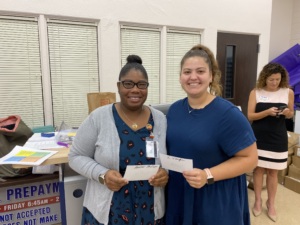
The goals of the program are to help a cohort of new teachers enter the classroom ready to be prepared from day one, create a more financially sustainable model for aspiring teachers to train, and also create better support and leadership opportunities for in-service teachers.
How the work started
BISD, Lamar University, and US PREP devoted about six months to planning this new residency program. During the planning year, they began by conducting a “learning tour” of a school in Houston that employed a residency model. They then devoted January to May 2023 to planning and officially opened up the residency program in August.
The learning tour offered several key lessons:
- Collins-Davis shared that often visitors from BISD “could not tell which teacher was the resident and which was the cooperating teacher.” This level of expertise suggested that the residency model could help aspiring teachers quickly develop a high level of skill.
- Panel discussions with residents, cooperating teachers, and campus leadership provided insight into both challenges and benefits of the program.
- Governance meetings between district, prep program, and partner schools are essential so that all viewpoints are considered before the actors make any decisions. Collins-Davis reported that, “These meetings help all parties feel heard and strengthen the partnership, and allow all to be involved in problem-solving and solutions.” As a result of this lesson, BISD implemented quarterly governance meetings to share updates, do data reviews, and identify needed improvements.
Funding stipends for student teachers and cooperating teachers
The residency program pays cooperating teachers a stipend of $4,000 per year, split between two semesters (previously, cooperating teachers received $600 per student teacher per semester). To make the increased stipend financially feasible, BISD selected a model (one of several proposed by US PREP) through which residents (also known as student teachers) cover classes on a limited basis to provide release time to cooperating teachers. This saves the district costs for substitute teachers, which they can instead allocate to stipends. It also allows cooperating teachers to act as mentors to novice teachers and teachers from alternative route pathways at their schools.

Residents earn $20,000 over the course of the year. They work three days a week in the fall and four days a week in the spring (and spend the other day or two in classes with their prep program). The stipend is partially covered by residents providing release time (i.e., acting as substitute teachers) for their cooperating teacher (as noted above). In the final quarter of the school year, residents also provide release time to other teachers throughout the school. This release time allows the residents to experience teaching in other grades and subjects, and it allows the teachers to engage in professional learning communities and to conduct peer observations. The release time is limited, building up to one full day a week (which is often broken up across several days).
Process to recruit and select cooperating teachers
- Narrow down a list of possible host schools: The district needed to limit the residency program to only a few schools. This would allow them to bring a cohort of residents into each school and also enable them to gain efficiencies from having cooperating teachers both support their residents and mentor novice teachers at schools with the greatest number of teachers currently in alternative route preparation programs. The district identified six potential schools, focusing on those with experienced and effective principals. The partner institution narrowed it further to three schools, based on where their previous cohorts of student teachers had positive experiences.
“Strong leadership is about crafting and fostering an environment that allows all members of the team to grow and meet their potential. We sought out principals who focused on creating an emotionally safe and secure environment that not only allowed risk-taking but encouraged it. This model is new and pushes individuals out of their comfort zone, so having that supportive culture was key in our decision-making.”Emily Collins-Davis, director of professional development
- Identify possible cooperating teachers: The district developed a list of teachers in the district who had at least three years of experience, a track record of strong student growth based on test data, and principal recommendations.
- Conduct learning tours: To allow potential cooperating teachers to see a residency program in action, including how co-teaching created more of a partnership and sharing of responsibility, the district invited all nominated cooperating teachers to attend a learning tour in Houston to see its residency program. On this tour, potential cooperating teachers sat in on classrooms and met with a panel of teachers, while host principals had the opportunity to speak with school leaders. Often, teachers who attended the learning tour encouraged other teachers from their schools to apply, suggesting they were excited by what they’d seen and growing the pool of potential cooperating teachers.
- Complete application process: Interested teachers completed a written application, including questions like, “Why is it important to help them grow future teachers?” and “What does it mean for you as a teacher to host a resident and also support other new teachers?”
- Hold interviews: Staff from Lamar University, the district, and school principals interviewed potential cooperating teachers using a rubric.
Process to select residents
- Identify possible resident students: Because this was a pilot year, the residency program was only open to a small number of teacher candidates. Lamar University reviewed information about who was doing well in coursework and appeared ready to become a resident, and nominated those teacher candidates.
- Host information session: The district visited the university’s campus and shared with potential residents its vision for the residency program and what the school district and specific placement schools were like.
- Complete application process: Teacher candidates interested in becoming residents submitted a one-minute video introducing themselves and sharing their goals for the program, which allowed the district staff to get to know the applicants and consider how best to match them with the right cooperating teachers. Principals could watch the videos and rank them to determine who would “mesh well” with cooperating teachers and the campus as a whole. Next, the district held panel interviews based on rankings; each principal interviewed about five residents. After the interviews, the principals, district leaders, and team from Lamar University (who sat in on all interviews) discussed whether and how to match each potential resident. The process ultimately resulted in nine resident-cooperating teacher pairings for the first year.
Building partnerships
The district took great pains to ensure that both the cooperating teachers and residents felt fully invested in the partnership. The process started early with training for both the cooperating teachers and residents, which included working out how best to communicate with each other. The district also ensured that cooperating teachers would be willing to share their classroom with their residents. It was a priority to integrate residents fully into their host schools: they invited residents to all meetings and professional development opportunities that other teachers attended, provided them with laptops just like the other teachers, and otherwise ensured that they were treated the same as every other teacher.

The district and Lamar University collaborated throughout the experience. They shared with each other information from walkthroughs conducted by program supervisors and school principals, and staff from both Lamar and the district joined meetings with cooperating teachers. The process is already prompting considerations for next year, surfacing “hotspots” that they want to address proactively in preservice training next year.
Outcomes
While the district does not yet have quantitative data to share, it’s hearing many positive reports. Students in classrooms have many more opportunities to work in small groups or receive intensive interventions because they have two adults in the room. Residents are growing in confidence, and their observation ratings have improved. Cooperating teachers enjoy the opportunity to engage with someone eager to enter the profession and to take on a leadership role. And other teachers on the campus receive additional support from cooperating teachers; on the district’s surveys, they report feeling “relief” when their mentor teacher comes in and appreciate receiving feedback on their instruction.
“The residency isn’t just about preparing preservice teachers; it’s about revitalizing classrooms. Cooperating teachers benefit from the fresh pair of eyes and most current teaching practices that the residents bring in. Other teachers at the campus have an opportunity to learn from one of their own. Most importantly, students in the classroom get to learn from multiple perspectives and build relationships with another safe adult who shares their goal for academic excellence.”Emily Collins-Davis, Director of Professional Development
The district plans to track rates of hiring for residents as well as retention rates for teachers who had access to a mentor as a result of the program.
Advice
While the district reports that the first year has been “incredible,” there are a few ways that it plans to change the process for the coming years, especially when trying to scale up the successes of the pilot year:
- Learning tours in other districts are helpful but unnecessary once your own program is up and running: They do not plan to bring teachers to Houston for a learning tour again; while the initial tour was very beneficial, potential cooperating teachers can now see the residency program in action in their own district.
- Videos as part of student teacher applications may be redundant: The district may cut the video entries from teacher candidates’ applications. Candidates’ personalities also came through during in-person interviews, and the video component was quite time-consuming. However, the district does intend to keep the panel interviews, as they played a large role in producing successful pairings.
“One thing we’ve gotten consistently amazing feedback on is that the resident and cooperating teacher matching was perfect! Both sides are very protective of their counterparts, they eat lunch together, the bond is amazing.” Emily Collins-Davis, Director of Professional Development

